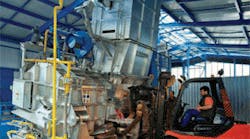Cost is always the deciding factor in manufacturing, but linking cost to performance is what keeps technology advancing. “The two principal cost drivers in the production of liquid aluminum are metal loss and energy consumption. When considered over the service life of a melting furnace, these factors are responsible for up to 95% of the overall costs,” according to Rudolf Riedel, manager of the StrikoWestofen Group. After unveiling a high-efficiency shaft furnace last year, to melt aluminum with lower energy consumption, StrikoWestofen is introducing two new developments that aluminum foundries may appreciate for raising the metallurgical quality of their cast products.
The PurEfficiency shaft furnace is designed to consume just 525 kWh of energy when melting and holding 1 metric ton of aluminum, a standard of energy efficiency previously achieved only by regenerative combustion. PurEfficiency series furnaces are available in fixed or tilt-able styles to produce 1,500-kg, 2,500-kg, or 3,500-kg per hour of aluminum. At Kovolit a.s. in the Czech Republic, a 1,500-kg twochamber melting and holding furnace achieved an energy consumption of 525 kWh/t, including melting and reheating for a constant bath temperature of 720°C. The increase in energy consumption is minimal during everyday operation, when holding operations regularly interrupt melting, according to the developer. It compares this furnace design to regenerative combustion furnaces in terms of energy efficiency, and rates it better than furnaces with cold-air burners.
In addition, the PurEfficiency series furnace design is only slightly larger than the comparable StrikoMelter furnace, with no difference in the height of the shaft.
Shaft furnaces use waste heat from the melting process to preheat the furnace charge. The integrated heat-recovery system ensures a high level of energy-efficiency; the rapid melting process minimizes metal oxidization. The shaft geometry makes it possible to achieve energy consumption levels below 600 kWh when melting and heating one metric ton of aluminum at 720°C. StrikoWestofen used CFD numerical simulation to evaluate different chamber geometries, burner layouts and insulation strengths, to arrive at the optimal flow system, heat transfer and temperature distribution for maximum energy and melting furnace.
To address the specific concerns of foundries, StrikoWestofen is unveiling two casting technologies that will extend its cost and quality objectives into the realm of finished products. Noting that castings are increasingly selected for structural applications where they are exposed to excessive stress (e.g., automotive suspensions), the developer aimed to improve the metallurgical homogeneity, strength, and viscosity of the metal as it is poured. A new, riser tube design for Westomat dosing furnaces prevents oxides from entering the metal stream during casting, supporting homogeneity in the metal and maintaining temperature fluctuations within 2°C of the nominal temperature.
In addition, to increase occupational safety and metal quality, StrikoWestofen is introducing a new filling device for Westomat furnaces. The pneumatic system is self-contained, so reactive metals will not be infiltrated by atmospheric impurities. The riser tube ensures a constant flow rate and laminar flow conditions for liquid aluminum straight into the filling hopper of the dosing system. As such, it’s unnecessary to tilt casting ladles at great heights, reducing operators’ risk and preserving metal quality. The new filling method can be adapted to any sizes of Westomat furnace, including existing designs.









